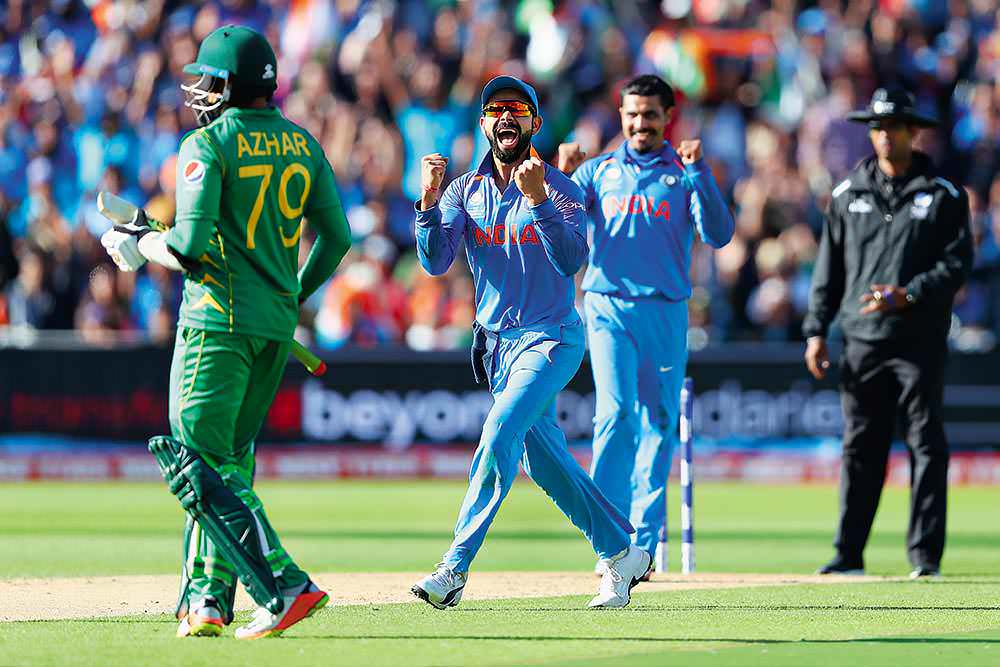A gullible nation, groomed for decades by television channels striving to maximise profit, has come to regard India vs Pakistan matches as proxy war

A Facebook post from an acquaintance, someone who knows his cricket well and the extreme unpredictable ways it can be played out, referred to the India-Pakistan Champions Trophy final match as a “gentlemen versus terrorists” clash. He was all set to watch the match, filling his refrigerator with cans of beer so that he would have enough stock to last him the eight-hour marathon show on TV.
Except for a muted protest from one of his friends, calling the term unfair as it was merely a cricket match, the rest were happy to let it be. An India-Pakistan match, even in the best of times, is like a war, where instead of guns being fired, it is a contest between a piece of broad wood, called the bat, and a leather-stitched round object called the ball. While the two sets of skills—bowling and batting—clash with each other, fans from the two sides, the majority sitting in their drawing rooms or bedrooms in front of television sets, go through a gamut of emotions, its ebb and tide largely dependent upon how well or badly their team is playing.
Since the number of those watching the match is phenomenal—an estimated 288 million watched their 2015 World Cup clash as compared to a mere 2.1 million that watched Australia play England; the Champions Trophy final at the Oval in London became the third highest watched match in the history of cricket—the stakes are bound to be high. Just like the live coverage of the Gulf War in the ’90s made CNN an international brand name, drawing an unprecedented global audience to the channel, an India-Pakistan match has, over the years, become the most lucrative cricket clash, where earnings of broadcasters shoot the roof. Millions of fans, and even those who care little for the sport, get drawn to the match, given the history of a bloody past--from Partition, that resulted in riots and the largest migration in humanity, followed by four wars over the decades.
Diese Geschichte stammt aus der July 03, 2017-Ausgabe von Outlook.
Starten Sie Ihre 7-tägige kostenlose Testversion von Magzter GOLD, um auf Tausende kuratierte Premium-Storys sowie über 8.000 Zeitschriften und Zeitungen zuzugreifen.
Bereits Abonnent ? Anmelden
Diese Geschichte stammt aus der July 03, 2017-Ausgabe von Outlook.
Starten Sie Ihre 7-tägige kostenlose Testversion von Magzter GOLD, um auf Tausende kuratierte Premium-Storys sowie über 8.000 Zeitschriften und Zeitungen zuzugreifen.
Bereits Abonnent? Anmelden

Layers Of Lear
Director Rajat Kapoor and actor Vinay Pathak's ode to Shakespeare is an experience to behold

Loss and Longing
Memories can be painful, but they also make life more meaningful

Suprabhatham Sub Judice
M.S. Subbulakshmi decided the fate of her memorials a long time ago

Fortress of Desire
A performance titled 'A Streetcart Named Desire', featuring Indian and international artists and performers, explored different desires through an unusual act on a full moon night at the Gwalior Fort

Of Hope and Hopelessness
The body appears as light in Payal Kapadia's film

Ruptured Lives
A visit to Bangladesh in 2010 shaped the author's novel, a sensitively sketched tale of migrants' struggles

The Big Book
The Big Book of Odia Literature is a groundbreaking work that provides readers with a comprehensive introduction to the rich and varied literary traditions of Odisha

How to Refuse the Generous Thief
The poet uses all the available arsenal in English to write the most anti-colonial poetry

The Freedom Compartment
#traindiaries is a photo journal shot in the ladies coaches of Mumbai locals. It explores how women engage and familiarise themselves with spaces by building relationships with complete strangers

Love, Up in the Clouds
Manikbabur Megh is an unusual love story about a man falling for a cloud. Amborish Roychoudhury discusses the process of Manikbabu's creation with actor Chandan Sen and director Abhinandan Banerjee